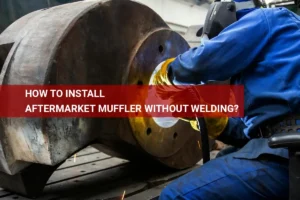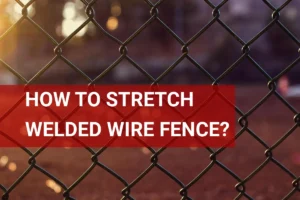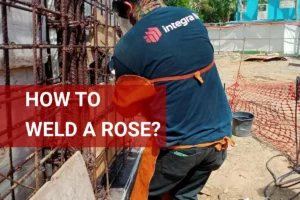How to Attach Welded Wire Fence to Wood Post? – Steps, Tips, and FAQs
Published on: February 9, 2025 | Last modified: March 4, 2025
By: Tyler James
A wire fence is a type of barrier made from interconnected wires. It’s often used for enclosures, security, or boundary marking.
So, how to attach welded wire fence to wood post? It’s super important to get this right. If the attachment’s weak, your fence won’t hold up against outside forces, and I learned that the hard way. Proper installation gives you peace of mind and durability for years to come.
In this article, I’ll cover what a welded wire fence is, types of welded wire fences, steps to attach welded wire fence to wood posts, factors influencing the attachment process, and frequently asked questions. Plus, we’ll touch on related topics like how to attach welded wire to wood for a comprehensive understanding.
Contents
- How to Attach Welded Wire Fence to Wood Post?
- What is Welded Wire Fence?
- Types Of Welded Wire Fences
- Steps to Attach Welded Wire Fence to Wood Posts
- Factors Influencing How to Attach Welded Wire Fence to Wood Post
- Alternative Methods for Attaching Welded Wire Fence to Wood Post
- Attachment Hardware Comparisons
- Frequently Asked Questions (FAQs)
- Conclusion
- References
How to Attach Welded Wire Fence to Wood Post?
A wire fence is a sturdy barrier made from metal strands. To attach a welded wire fence to a wood post, use 8-12 gauge staples, placing them every 2 feet (0.61 Meters). This method is easy, perfect for gardens and livestock enclosures. Mastering the techniques for welding different gauge metals can greatly enhance your fencing projects, especially when learning how to weld 16-gauge sheet metal.
What is Welded Wire Fence?
A welded wire fence is made from steel wires that are electrically welded together. These fences typically feature openings ranging from 2 inches (5.08 Cm) to 6 inches (15.24 Cm), providing secure enclosures while allowing visibility and airflow. The steel wires measure 12 to 14 gauge in thickness, offering durability and strength. This material is often galvanized to resist rust, extending its lifespan up to 25 years or more, depending on conditions.
When attaching welded wire fence to wood posts, it’s crucial to ensure a secure hold. You can use staples or a fence bracket, depending on your preference. I’ve found that using a staple gun works best for a tight fit, reducing sagging over time. It really makes a difference in how secure the fence feels.
For work, I relied on it to secure livestock on my farm. I needed to attach the welded wire fencing to wood posts securely. Adding this layer of security was vital, especially when learning how to attach welded wire fence effectively, as it prevented animals from roaming freely. I spent hours figuring out the best staples to use, ensuring my fence was robust enough for any challenge.
Types Of Welded Wire Fences
What are the types of welded wire fences, and how can you secure them to wood posts?
Heavy-duty Welded Wire Fences
These thick, robust fences are perfect for strong containment. To fasten them to wood posts, use a combination of staples and tension wires. Start by nailing heavy-duty staples into the post, securing the wire tightly for added strength. When refining such connections precision is key and knowing the best approaches to cutting welds effectively can enhance your installation techniques.
Lightweight Welded Wire Fences
Ideal for garden areas, this type is easier to handle but still effective. To attach, use lighter staples and tie the wire to the post. First, pull the wire tight and fasten it with regular fencing staples spaced about 12 inches (30 Cm) apart.
When connecting delicate components, understanding the techniques to securely weld thermocouple wire can be crucial for ensuring accurate temperature readings. Follow this process to ensure your setup is both reliable and long-lasting by referring to how to weld thermocouple wire.
Vinyl-coated Welded Wire Fences
This style offers protection and aesthetic appeal with its colorful coating. For attachment, plain staples work fine. Simply run the coated wire along the post and use staples spaced every 12 inches (30 Cm), ensuring not to puncture the vinyl too deeply.
Galvanized Welded Wire Fences
These fences are treated to resist rust, making them long-lasting. Attach the wire using galvanized screws or staples. Ensure you pre-drill holes before screwing to avoid splitting the wood.
Rust-resistant Welded Wire Fences
Similar to galvanized fences but with additional protective coatings. Use stainless steel fasteners for longevity. To attach, position the wire against the post and secure it with screws or corrosion-resistant staples for a reliable hold.
Proper handling in manufacturing can prevent issues such as porosity in welding.
We covered the various types of welded wire fences. Next, we will discuss how to attach welded wire fences to wood posts.

Steps to Attach Welded Wire Fence to Wood Posts
Here are the steps to effectively attach your welded wire fence to wood posts.
Prepare the Wood Posts
Start by positioning the wood posts for your fence. Space them about 6 to 8 feet (1.8 To 2.4 Meters) apart, depending on the fence height and local regulations. Ensure the posts are at least 2 feet (0.6 Meters) deep for stability. Use a level to check their vertical alignment—it shouldn’t lean!
Once in place, secure the posts with concrete or gravel for added strength. In humid climates, consider using treated wood to prevent rot. Take your time to align the posts correctly; a slight misalignment can affect the entire fence.
Measure and Cut the Wire
Next, roll out the welded wire fence alongside the posts. Measure the height needed and cut the wire, adding an extra 2 to 3 inches (5 to 7.6 Cm) for overlap. Standard fence height is usually around 48 to 60 inches (1.2 To 1.5 Meters). Use a wire cutter for a clean cut to avoid sharp edges later.
After cutting, lay the wire flat against the posts and straighten any kinks. This step is vital for a neat installation. A twisted appearance can be frustrating later. Remember, measure twice and cut once to save hassle.
Attach the Wire to the Posts
Position the welded wire against the wood posts, starting at the bottom. Use U-nails or screws designed for fencing, securing the wire to each post. Space them approximately every 12 to 24 inches (30 to 61 Cm) along the height to keep the wire taut and reduce sagging. Spacing can vary based on wire gauge and local wind conditions.
Pull the wire tight as you go—you don’t want it flapping in the wind later. Avoid excessive pressure to prevent bending the posts or damaging the wire. It’s essential to keep it snug but not overly tight.
Secure the Wire With Ties
After securing the wire to the posts, reinforce your work. Use wire ties or fencing clips to secure the welded wire. Space the ties every 18 inches (46 Cm) for durability. Diagonal wire ties can provide added strength against lateral pressure.
It is crucial to address safety in welding practices as electrical mishaps can arise. Understanding common causes of electric shock highlights the importance of proper precautions in the welding industry.
Remember, wire ties can degrade over time due to weather if they’re not UV resistant. Choose stainless steel when possible. A well-tied wire can significantly improve the fence’s service life.
Check Stability Of the Fence
Finally, check your newly installed fence. Give a gentle push against the wire to see if there’s any movement. The posts should feel firmly in the ground without wobbling. If something seems off, reinforce it before completing the installation.
Inspect each section to ensure the wire is taut against the posts and adjust ties as needed. Taking this extra time ensures your fence lasts for years. No one likes reinstalling their fence due to skipping a step!
You should now have a good understanding of attaching welded wire fence to wood posts. In the next part, we’ll discuss factors affecting this process.
Factors Influencing How to Attach Welded Wire Fence to Wood Post
What factors impact securing a welded wire fence?
Type Of Welded Wire Fence
The type of wire fence significantly impacts attachment. Heavier gauges (Like 12-gauge or 14-gauge) require stronger connectors to handle tension, while lighter wire can use simpler methods.
Height Of the Wood Posts
Shorter posts (3 to 4 Feet) need less support than taller ones (6 to 8 Feet). Taller posts increase wind resistance, requiring sturdier connections to prevent leaning.
Weather Conditions
Harsh weather can strain your fence. High winds (Above 25 Mph) can topple poorly secured fences. A firm attachment helps resist these stresses.
Soil Type and Stability
Stable, compact soil (Like Clay) supports posts better than sandy soil, which tends to shift. This stability plays a vital role in how well the fence holds over time.
Accessory Hardware Used
Using the right hardware, like fence staples or tie wires, matters. Galvanized hardware lasts longer and resists rust better than non-galvanized varieties.
That covers the factors influencing the attachment of welded wire fences to wood posts. Let’s now take a look at alternative methods.
Alternative Methods for Attaching Welded Wire Fence to Wood Post
If you’re looking for options, here are some alternative methods to attach a welded wire fence to wood posts.
Using Fencing Clips
Fencing clips are a robust alternative. Place the wire against the post and use clips to fasten it. Space clips every 18 to 24 inches (46 to 61 Cm) for maximum hold.
Screws and Washers
Instead of staples, consider using screws with washers. This method prevents pull-through, especially in windy areas. Choose screws that are at least 3 inches (7.6 Cm) long for strength.
Wire Tensioning Devices
For secure tension, use tensioning devices. These help maintain wire pull without loosening over time. Install a tensioning device at every 20 to 30 feet (6 to 9 Meters) for consistency.
We’ve wrapped up alternative methods for securing welded wire fence to wood posts here. Next up, we’ll look at hardware comparisons.

Attachment Hardware Comparisons
| Hardware Type | Material | Spacing Recommendation | Durability |
|---|---|---|---|
| Fencing Staples | Galvanized Steel | Every 12-24 inches (30-61 Cm) | Good |
| Washing Screws | Stainless Steel | Every 18-24 inches (46-61 Cm) | Excellent |
| Fencing Clips | Metal | Every 18-24 inches (46-61 Cm) | Very Good |
| Tensioning Devices | Metal | Every 20-30 feet (6-9 Meters) | Outstanding |
Frequently Asked Questions (FAQs)
Now let us look at some common questions I typically get asked.
How Do You Secure a Welded Wire Fence to Wood?
To secure a welded wire fence to wood, you can use fencing staples or a heavy-duty wire. These options provide strong attachment points, ensuring the fence remains stable. Using at least four staples (1.6 Cm) on each post offers good leverage against weather and tension forces.
How Do You Attach a Metal Fence to a Wooden Post?
To attach a metal fence to a wooden post, use U-brackets or metal clips. These fasteners can handle the weight of the metal. Typically, two brackets for each section (Spacing About 30 Cm) ensures a sturdy connection that can withstand wind loads.
What Fastener is Used to Attach Fence Wire to Posts?
Common fasteners for attaching fence wire to posts include fencing staples and zip ties. Fencing staples, made from galvanized steel, resist rust and hold tightly, while quality zip ties support light-duty wires. Use at least 4 staples (2.5 Cm) for greater stability.
How to Connect Welded Wire Fence Together?
To connect welded wire fences together, you can use wire ties, metal clips, or twisting wire ends. Each connection method allows for flexibility while maintaining structural integrity. By securing connections every 60 cm, the fence stands firm in windy conditions.
How to Join Welded Wire Fence?
To join welded wire fence sections, overlap the edges and secure with wire tensioning tools or clips. This method strengthens the joint and prevents sag. A 30 cm overlap is often recommended for joints exposed to heavy loads.
How to Attach Welded Wire to Wood?
You can attach welded wire to wood using staples or heavy-duty nails. Staples provide a secure hold at various speeds. Aim for every 30 cm along the wood edge for optimal strength and durability against the elements.
Conclusion
Phew, that’s a lot to cover. We discussed what a welded wire fence is, identified various types of welded wire fences, and outlined clear steps to attach welded wire fence to wood posts. We also touched on factors influencing how to attach welded wire fence to wood posts and answered common FAQs.
I hope these welding tips prove valuable to you. To attach welded wire fence to wood post, use galvanized nails, wire ties, or staples to secure the fence firmly. Remember, using the right tools and following steps will make the job easier and ensure your fence holds up over time.
For further insights into the world of welding, visit What is Welding.
References
- ISO. (2017). ISO 3834: Quality Requirements for Fusion Welding of Metallic Materials. Geneva, Switzerland: ISO.
- American Welding Society. (2020). AWS C5.6: Recommended Practices for Gas Metal Arc Welding. Miami, FL: AWS.
- Howard B. Cary. (1997). Welding Manual. Upper Saddle River, NJ: Prentice Hall.
Tyler is a passionate DIY welder and self-taught metal artist with years of hands-on experience transforming raw materials into functional and artistic creations. Specializing in MIG welding, Tyler crafts everything from custom furniture to outdoor sculptures, blending creativity with technical skill. Committed to making welding accessible, Tyler shares practical insights and project inspiration to help beginners and hobbyists confidently explore the world of metalworking.
American Welding Society, Fencing Tips, How-to Guide, Livestock Enclosures, Outdoor Fencing, Regulations, Structural Integrity, Welded Wire Fence, Welding, Wire Gauge, Wood Post Installation







